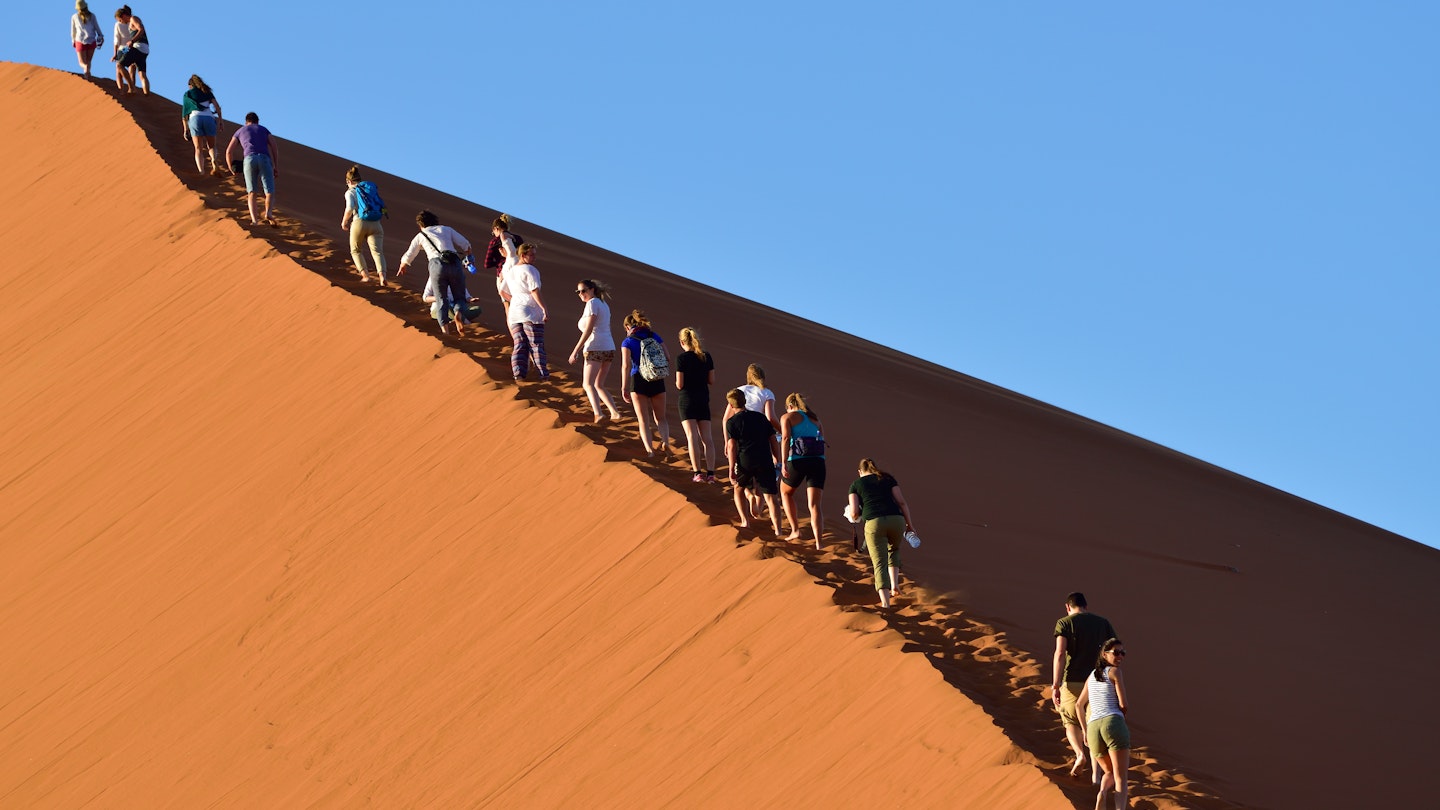The Best National Parks in Namibia
The true magic of Namibia lies in its wide-open spaces. In this vast country, you’ll encounter lonely landscapes of ancient deserts where dunes roll to the horizon, desolate shorelines come wreathed in morning fog, and salt pans teem with rare antelope emerging from the shimmer of afternoon heat, plus rare corners where the desert relents and relaxes into lush riverine forests.
You’re never short of a fine view just about anywhere in Namibia, but with easy self-drive access, affordable entry fees, and a range of accommodations, the network of national parks offers perhaps the best way to discover the country’s enigmatic landscapes.
Wildlife Watchers Shouldn’t Miss Etosha National Park
While not the largest park in the country, Etosha National Park is the best game reserve in Namibia and is certainly the most famous one for spotting wildlife. Etosha’s diverse habitat of savanna and woodland plays host to a passing parade of fauna, including endangered rhinoceros, cheetah, and an array of lesser-known antelope species. Ever wanted to spot a dik-dik, roan, or black-faced impala? Etosha is just the place. The dry winter months of May to October are best for game viewing, as evaporation makes the animals cluster around permanent watering holes.
The highlight for most visitors is the eponymous Etosha Pan, a vast salt basin that stretches across 5000 sq km (1931 sq miles) to cover nearly a quarter of the national park. Bone-dry for much of the year, the pan fills with summer rainfall from November to April, transforming it into a shimmering shallow lake that draws a remarkable array of animal and bird life.
Etosha National Park is an ideal option for self-driving travelers, with well-maintained gravel roads and a choice of accommodations. Five public resorts and campsites are spread across the park, catering to diverse budgets and preferences. At larger camps, you’ll find a good range of facilities, including gas stations and restaurants. Guided game excursions are offered at most camps in the early morning and late afternoon.
Adventurous Families Will Love Namib-Naukluft National Park
Covering some 49,000 sq km (18,919 sq miles), the ochre dunes of Namib-Naukluft National Park make up the heart of Namibia’s largest national park. In the world’s oldest desert, these sandy mounds have spent the last 55 million years marching inland from the Atlantic Ocean.
Sossusvlei is one of the park’s most iconic features. This area is famous for towering dunes that reach as high as 325m (1066ft) and for the enigmatic Deadvlei, an area of desiccated camel-thorn trees, carbon-dated to more than 500 years old and forever rooted in a bone-dry pan of white clay.
The dunes come alive at dawn, and staying within national park boundaries offers pre-dawn access that allows you to enjoy an uninterrupted spectacle of nature. Kids love climbing up the towering dunes and running down from the top – but the best views of all are looking down on the dunes from a hot air balloon. Dawn flights soar above the grasslands of neighboring conservancies.
While Sossusvlei is the highlight, Namib-Naukluft National Park has much more to discover. Carved by the Tsauchab River, Sesriem Canyon offers fascinating rock formations and walking trails, while the lagoon at Sandwich Harbour is one of Namibia’s most important coastal wetlands and a hotspot for birding.
Experience Unique Coastal Landscapes and Wildlife at Skeleton Coast National Park
Stretching for 500km (311 miles) along Namibia’s western coast, Skeleton Coast National Park is perhaps the most desolate corner of a country never short on lonely landscapes. Here, the sun beats mercilessly on rolling dunes and rocky canyons, while dense fog envelops the coast each morning. Through the gloom, the rusted ribs of ships litter the shoreline, lending the national park its name.
The Skeleton Coast might seem empty – but there is plenty of life if you know where to look. On the gravel plains, the long-lived Welwitschia mirabilis is a wonder of the plant world. Though it has only two long, leathery leaves and grows in arid, sun-baked soils, the oldest Welwitschia are estimated to be more than 2000 years old.
Offshore, look for Benguela dolphins and, from June to August, migrating humpback whales. Inland, the lucky might spot a brown hyena shuffling across the sand. Toward the Kaokoveld in the park’s eastern reaches, the canyons and dry riverbeds are home to rhinos, desert-adapted elephants, lions, and a diversity of antelope species.
|Ai-|Ais/Richtersveld Transfrontier Park Offers Multi-Day Hikes and Hot Springs
Straddling South Africa and Namibia, the vast |Ai-|Ais/Richtersveld Transfrontier Park conservation area is home to the Fish River Canyon, the second-largest on Earth. You can admire the canyon’s sinuous curves from the viewpoint near Hobas Lodge, but tackling the 85km (53-mile) multi-day hike is the best way to immerse yourself in this breathtaking African natural wonder.
The trail is open only in the cooler winter months of May to September, and hikers need to be self-sufficient in terms of food, shelter, and equipment. It’s aimed at experienced hikers, who are rewarded at the end with cold beers and hot mineral springs – the name translates to “burning water” in the local Nama language. At the /Ais Hot Springs Spa, weary hikers will be glad to soak in the soothing waters that burble into spacious indoor and outdoor pools.
Enjoy Water, Wildlife, and Birding at Bwabwata National Park
In the northeastern Zambezi Region, Bwabwata National Park is one of Namibia’s newest national parks and showcases an entirely different side of the country. The dunes and gravel plains common across Namibia are replaced here by lush Kalahari woodlands and wide rivers. You’ll find large herds of elephant, buffalo, and antelope within the park, and during the wet summer months, you can spot up to 400 species of birds.
Independent travel is challenging in Bwabwata, and you’ll need a 4×4 to explore much of the park. However, a handful of private lodges offer luxury accommodations, game drives, guided walks, and boat cruises, enhancing the wildlife exploration experience.





